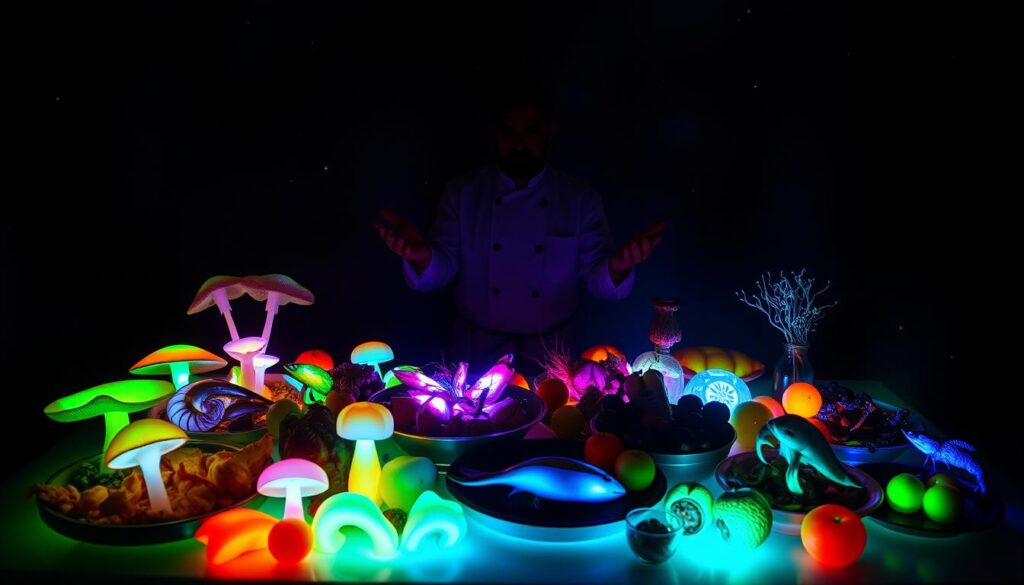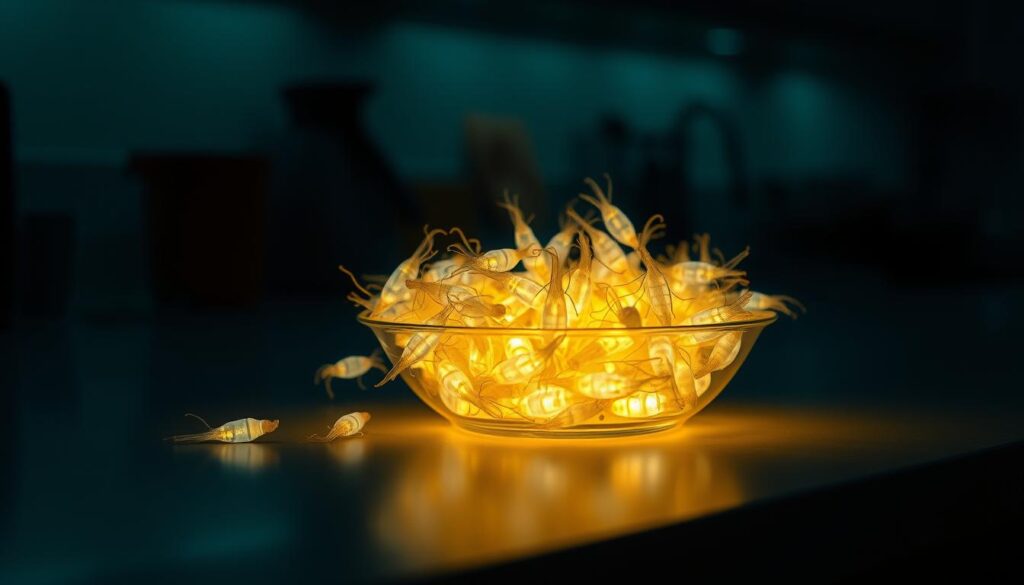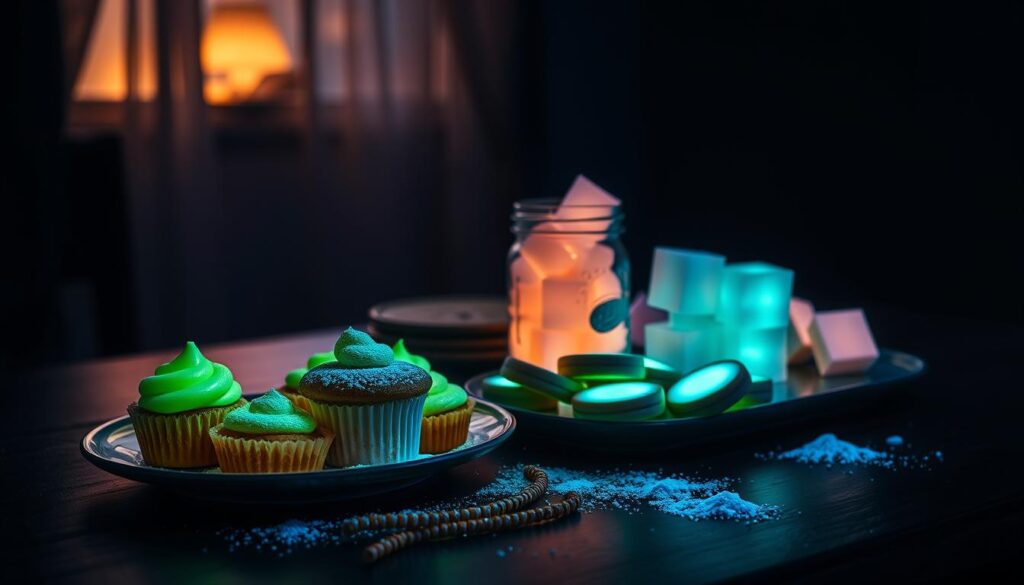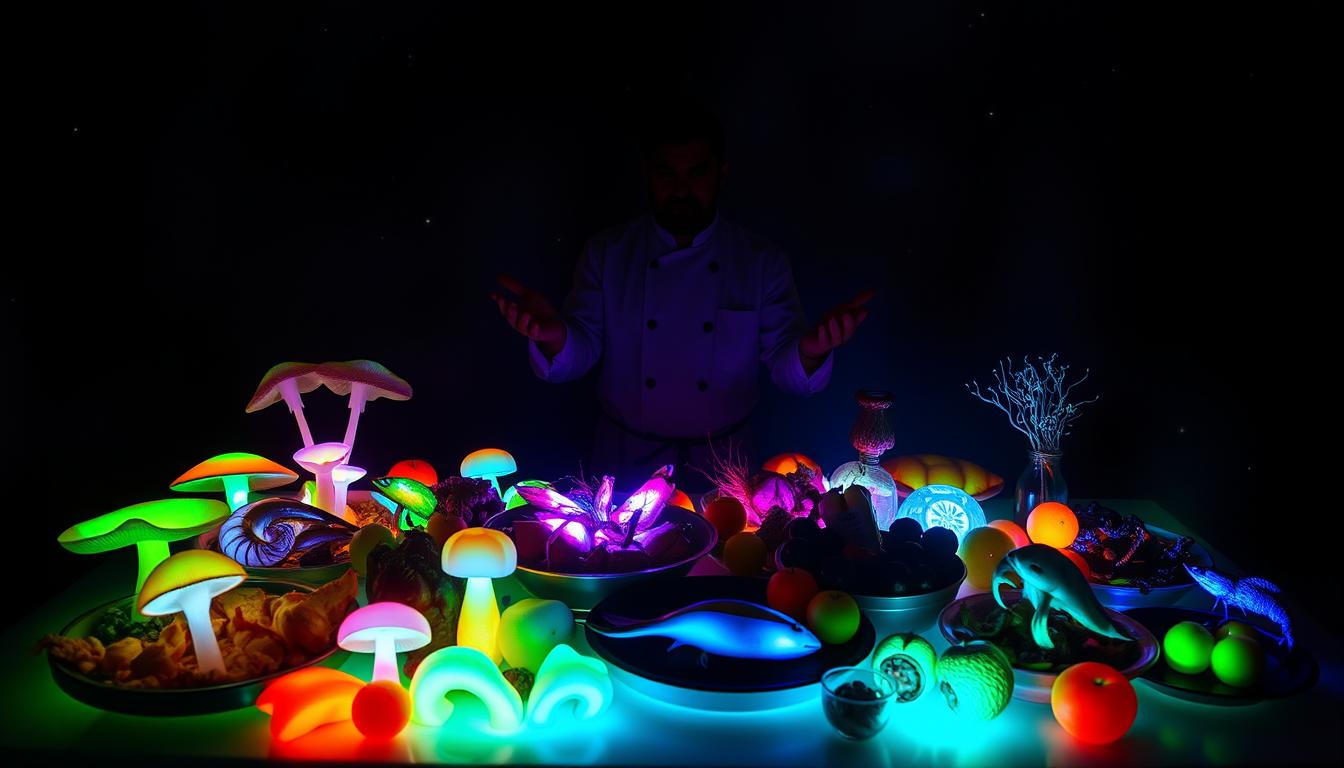Imagine enjoying a meal that glows in the dark. This is a real wonder of bioluminescent food. It’s becoming more popular, and the world of glow-in-the-dark dishes is getting more interesting. You can find unique dining spots and creative recipes everywhere.

Bioluminescent food isn’t new, but using it in cooking is still a new area. As we explore glow-in-the-dark cuisine, we’ll learn about its science and uses. Whether you love food, science, or trying new things, this journey will amaze and inspire you.
Key Takeaways
- Bioluminescent food is a growing trend in the culinary world
- Glow-in-the-dark cuisine offers unique dining experiences
- The science behind bioluminescent food is complex and fascinating
- Creative recipes and applications are being developed
- Bioluminescent food has the potential to inspire new culinary innovations
- Glow-in-the-dark cuisine is becoming increasingly popular in the United States
- Exploring bioluminescent food can lead to new discoveries and experiences
The Science Behind Luminescent Cuisine
Luminescent dining is a unique experience that combines food that glows with an immersive atmosphere. It has become popular in recent years. Many restaurants and chefs now experiment with food that glows to create unforgettable experiences for their customers.
The science behind luminescent cuisine is based on bioluminescence. This is when living things produce light. We see it in fireflies, glowworms, and some plankton. In luminescent dining, bioluminescence is used to make food and drinks glow.
To make food glow, several methods are used. These include luminescent additives, chemical reactions, and natural ingredients that light up. Some common techniques in luminescent dining include:
- Using glow-in-the-dark ice cubes or garnishes
- Creating glow-in-the-dark cocktails or drinks
- Adding luminescent powders or dust to food
As more people want luminescent dining experiences, chefs and restaurateurs are exploring new ideas. They are making everything from glow-in-the-dark desserts to luminescent main courses. The future of luminescent cuisine is looking very bright.
Naturally Occurring Food That Glows in the Dark
Imagine enjoying a meal that glows with an edible glow. This is thanks to bioluminescent organisms that light up. They use light to talk, defend themselves, or lure in prey. You can find these light-making beings in many places around the world.
Some of these bioluminescent organisms are not only cool to watch but also safe to eat. For example, glowing mushrooms can add a special touch to dishes. They make the food glow. Also, plankton can be used in food, offering a green and natural choice instead of artificial stuff.
- Certain species of squid that contain bioluminescent organisms in their bodies
- Glowing mushrooms that can be found in forests and used as a unique ingredient
- Plankton that can be harvested and used as a natural ingredient in food products
These examples show how edible glow is all around us. They also show the chance for new, green food products.
The World of Artificial Glowing Foods
Artificial glowing foods are getting more popular. Many makers add luminescent additives to their products. These foods glow and offer a fun eating experience.
The FDA has approved these additives for safety. This means we can enjoy these glowing foods without worry.
Some fun examples include glow sticks, glow-in-the-dark ice cream, and drinks. These items use FDA-approved additives. The additives react with oxygen to glow.
There are a few ways to make drinks glow. Luminescent additives, LED lights, or glow sticks can do the trick. Additives are the most common choice because they’re safe and simple.
Popular glowing drinks include cocktails, soda, and juice. They add a cool twist to our meals and drinks.
- Glow sticks
- Glow-in-the-dark ice cream
- Glow-in-the-dark beverages
Glowing foods and additives are a big trend in the food world. Many companies are adding them to their menus. These products are a big hit, especially with the younger crowd.
Safety Considerations and Edibility
When it comes to eating glow-in-the-dark food, food safety is key. It’s important to make sure the ingredients used are safe and can be eaten. Ingredients like glow sticks, glow powder, and edible glow dust are often used.
To keep edible glow safe, follow certain steps. Wash your hands well before and after touching glow-in-the-dark food. Also, make sure all tools and surfaces are clean. Store this food in a cool, dry spot to avoid contamination.
Here are some important safety tips for eating glow-in-the-dark food:
- Always check the ingredients used to create the glow effect to ensure they are non-toxic and edible.
- Follow proper handling and preparation procedures to prevent contamination.
- Store glow-in-the-dark food in a cool, dry place to prevent spoilage.
By following these tips, you can enjoy glow-in-the-dark food safely. This ensures food safety and edible glow safety.

Creative Applications in Modern Gastronomy
Glow-in-the-dark dining is gaining popularity fast. It’s changing the way we enjoy food, from fancy dinners to parties. Luminescent cuisine is more than just food; it’s an experience.
Picture this: a dinner party where everything glows in the dark. Food, drinks, and decorations light up the night. This magic happens with glow sticks, neon lights, and special additives.
Fine Dining Experiences
Top restaurants are adding glow-in-the-dark touches to their menus and decor. It brings a new level of elegance to dining. Some highlights include:
- Glow-in-the-dark sushi
- Luminescent cocktails
- Neon-lit dessert buffets
Party and Event Planning
Glow-in-the-dark parties are all the rage. They create unforgettable moments for everyone. Here are some ideas to make your party glow:
- Glow-in-the-dark decorations
- Luminescent food and drinks
- Neon-lit photo booths
Making Your Own Glowing Treats
Making DIY glow-in-the-dark food is fun and exciting. You can create bioluminescent recipes at home with the right ingredients. Try making glowing desserts or radiant drinks for endless possibilities.
You’ll need tonic water, glow sticks, or edible glow powder to start. Mix different ingredients for unique flavors. Here are some ideas:
- Glowing cocktails with tonic water and glow sticks
- Bioluminescent desserts like glowing cupcakes or ice cream
- Radiant snacks, like glow-in-the-dark popcorn or fruit kebabs
It’s crucial to follow food safety guidelines when making glowing treats. This ensures they are safe and delicious. With practice, you can impress everyone with your creations.

Always use food-grade ingredients and follow proper handling and storage. This prevents health risks. With these tips, you can make amazing DIY glow-in-the-dark food for any party.
| Ingredient | Description |
|---|---|
| Tonic water | A sparkling water that contains quinine, which glows under black light |
| Glow sticks | Small, portable lights that can be used to create glowing effects |
| Edible glow powder | A food-grade powder that can be used to create glowing effects in food and drinks |
Cultural Impact of Luminescent Foods
The rise of glow-in-the-dark food culture has been a big deal lately. Bioluminescent trends have taken the culinary world by storm. This unique food aspect has caught the eye of chefs and food lovers alike. It has also made a big splash on social media and in cultural celebrations.
People sharing their glow-in-the-dark food experiences on social media has helped grow its popularity. Food bloggers and influencers have played a big role in promoting this trend. They share their glow-in-the-dark recipes and experiences. Hashtags and tagging have also helped create a community among enthusiasts, where people share their creations and discoveries.
Glow-in-the-dark food culture has also become a big part of festivals and celebrations. Many events now include glow-in-the-dark food and drinks. This adds excitement and wonder to the experience. Some popular examples include:
- Glow-in-the-dark cocktails and drinks
- Bioluminescent desserts and sweets
- Luminescent street food and snacks
The cultural impact of luminescent foods has been huge. Glow-in-the-dark food culture and bioluminescent trends continue to inspire and captivate people worldwide. As this trend evolves, it will be exciting to see how it shapes the future of food and culinary culture.
Environmental Implications
The making and eating of glow-in-the-dark food harm our planet. As more people want sustainable glow-in-the-dark food, we must think about how it affects the environment. Using eco-friendly bioluminescence can lessen the harm.
Sustainability Concerns
There are big worries about glow-in-the-dark food. These include using up non-renewable resources, using a lot of energy, and making a lot of waste. To fix these problems, we need to use eco-friendly bioluminescence. This means using green energy and cutting down on waste.
Eco-Friendly Alternatives
There are green options for glow-in-the-dark food. These include using plants that glow and packaging that’s good for the planet. These choices help make the glow-in-the-dark food world better for our planet.
Some green options are:
- Using edible flowers that naturally glow in the dark
- Creating bioluminescent desserts using sustainable ingredients
- Developing eco-friendly packaging for glow-in-the-dark food products
By choosing these green options and supporting eco-friendly bioluminescence, we can make glow-in-the-dark food better for our planet. This helps create a greener food industry.
Future of Bioluminescent Cuisine
The future of glow-in-the-dark food is exciting and changing fast. Bioluminescent trends are popping up everywhere in the food world. As tech gets better, we’ll see more cool uses of bioluminescence in food.
One cool thing coming is using microorganisms for green lighting in restaurants and parties. Also, new glow-in-the-dark foods might come out thanks to food technology.
Here are some trends to watch:
- More bioluminescent organisms in food making
- New glow-in-the-dark foods and products
- Greener lighting for the food world
As bioluminescent food grows, so will the demand for it. Social media will make glow-in-the-dark food even more popular. Imagine a dinner party or a restaurant that glows in the dark. The future of glow-in-the-dark food is bright and full of possibilities.
| Bioluminescent Trend | Description |
|---|---|
| Microorganisms | Use of microorganisms to create sustainable lighting solutions |
| Food Technology | Advancements in food technology to create new glow-in-the-dark ingredients and products |
| Sustainable Lighting | Development of eco-friendly lighting solutions for the food industry |
Health Benefits and Risks
Many people are curious about the health aspects of glow-in-the-dark food. Some foods glow due to unique nutritional properties, while others might have artificial additives. Research is ongoing, but some studies hint at health benefits from bioluminescent nutrition.
Some key health benefits of glow-in-the-dark food include:
- High antioxidant content, which can help protect against cell damage and reduce inflammation
- Potential anti-inflammatory properties, which may help alleviate symptoms of certain diseases
- Unique nutrient profiles, which can provide essential vitamins and minerals
But, not all glow-in-the-dark foods are safe. Some may have artificial additives or chemicals that are bad for our health. It’s important to know the risks and choose wisely when eating these foods.
Understanding the health aspects of glow-in-the-dark food helps us make better choices. It lets us enjoy bioluminescent cuisine safely. More research is needed, but current evidence shows glow-in-the-dark food can be a fun, healthy part of our diet.
Conclusion: Illuminating the Future of Food
As we wrap up our look at glow-in-the-dark food and bioluminescent cuisine, it’s clear this field is full of promise. It combines natural wonders with creative dishes, making it both fascinating and inspiring.
The safety and rules around glowing food are key, but its uses are vast. It could change fine dining, events, and even our daily meals. As tech improves, we’ll see more glow-in-the-dark food in our lives, exciting our senses and sparking our creativity.
For food lovers or anyone who loves nature’s magic, the future of bioluminescent cuisine is exciting. It’s a journey of wonder, creativity, and the extraordinary. As we explore new possibilities, let’s dive into the enchantment of glow-in-the-dark food.
FAQ
What is bioluminescence, and how does it create glow-in-the-dark food?
Bioluminescence is when living things make light through a chemical reaction. In food, it’s when certain organisms like plankton, fungi, and bacteria glow. This happens when they’re used in cooking.
What are some examples of naturally occurring glow-in-the-dark food?
Naturally glowing food includes bioluminescent mushrooms and certain plankton in seafood. Even some cheese-making bacteria can glow.
Are there any FDA-approved luminescent additives used in food production?
Yes, the FDA has approved some additives for glow-in-the-dark food. These include synthetic versions that mimic natural bioluminescence.
What are some popular glow-in-the-dark food products available on the market?
You can find glow-in-the-dark cocktails, jelly desserts, and even ice cream and sorbets. They use natural or synthetic bioluminescent ingredients for their glow.
What are the safety considerations when consuming glow-in-the-dark food?
It’s key to make sure the glow-in-the-dark food is safe to eat. Always follow safety guidelines and talk to a doctor if you have allergies.
How can glow-in-the-dark food be incorporated into modern gastronomy?
Glow-in-the-dark food can be used in many ways, like in fine dining or for parties. It adds a magical touch to meals.
What are the environmental implications of glow-in-the-dark food?
Glow-in-the-dark food is fun but we should think about its impact on the environment. We need to find eco-friendly ways to make it and use it.
What are the potential health benefits and risks associated with consuming glow-in-the-dark food?
The health effects of glow-in-the-dark food depend on what’s in it and how it’s made. We should look at its nutritional value and any research on eating bioluminescent foods.
